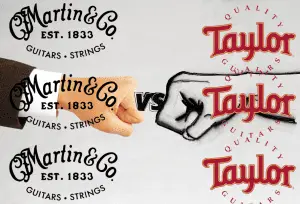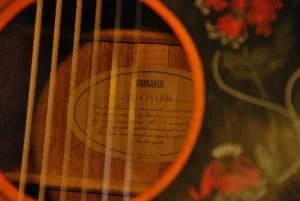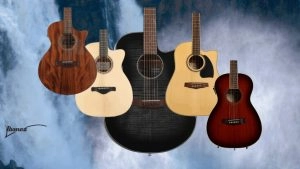Guitar licks are short melodic lines played on your guitar. A guitar lick can be a single note or a series of notes strung together to create an artistic, rhythmic pattern.
Licks are like mini solos. They might fill space between choruses and verses. And when played live, they’re typically wholly improvised but still fit nicely in the song. They make a song memorable.
And if you can learn a few guitar licks, you’ll be well on your way on your guitar-playing journey.
I love learning and practicing guitar licks that great players created because they help develop your technique and understanding of music theory.
I’m a huge fan of incorporating licks into your daily practice routine, as they’re great exercises for learning music theory and developing your technical playing skills.
In this article, I will help you better understand the concept of guitar licks, offer some of the best examples, and highlight some resources that can help you learn how to replicate famous licks and come up with some originals of your own.
• • •
Guitar Licks vs. Guitar Riffs
Guitar riffs and licks are commonly confused. Allow me to clear things up.
What Is a Guitar Lick?

When most people talk about guitar licks, they’re usually referring to the short solos sprinkled throughout a song. These can be single notes or short phrases strung together.
Think of a song as the main entree and the handful of guitar licks throughout that song as the salt and various spices. Guitar licks complete the song, but if there are too many of them, they become a bit too much — just like having too much seasoning or salt in an entree.
What is a Guitar Riff?
A guitar riff is a longer form of music that generally contains multiple parts. It’s the foundation for many popular songs, and it’s what you’ll typically hear in a song when you just start picking up the instrument.
Riffs are a crucial building block of rhythm guitar playing, and unlike licks, they’re mostly made up of chords or power chords. They can also include a melodic musical phrase or two, but these are usually less prominent in a riff.
Still confused? Let’s look at some examples of famous guitar riffs.
Think Eric Clapton’s signature riff in “Wonderful Tonight.”
Jimi Hendrix’s genius guitar riff on “Purple Haze.”
The riff of “Smoke On The Water” by Deep Purple.
AC/DC’s “Back In Black” is an excellent example of power chords and a lick working together to create an epic riff.
A riff can be simple or complex, but it’s essentially the foundation of a song.
Interestingly enough, guitar riffs are often copyrighted, while licks are free to copy.
Sure, the line between the two can be a little blurry, but for the most part, you can identify a song’s main riff versus the lead player filling in some dead space with a lick or two.
• • •
Guitar Licks vs. Guitar Solos
The difference between guitar licks and solos is much easier to explain than the difference between licks and riffs.
A guitar solo is typically performed during a predetermined time in the song. Maybe it’s after the third verse or the bridge of the song — and then the lead player is given 8, 12, or more bars to solo.

While a guitar lick is improvised much like a solo, it’s typically a short melodic phrase that the player sprinkles into the song.
A guitar solo can actually be made up of multiple licks, which is why teachers and longtime players love practicing licks. Building off licks is a great way to develop your soloing skills.
As I previously explained, guitar licks are short, memorable phrases throughout a song.
Guitar solos are more extended and more complex phrases.
• • •
Practice the Building Blocks of a Great Guitar Lick
Practicing guitar licks is one of the most important things you can do if you want to improve your skills as a guitar player.
There are a few reasons why practicing guitar licks is so important.
1. Licks are a fundamental part of most songs. Most people can learn the chord progressions of top songs, but by knowing the individual licks in those songs, you can really start to sound like a guitar master and improve your skills as a player.

2. Licks are easy to remember and learn. You’re not necessarily learning an entire song — you’re only learning small parts of that song, which is easier to memorize. As you learn and memorize more licks, your fingers and musical brain develop a sort of muscle memory, which allows you to incorporate your own original licks into songs.
3. You can apply licks to a wide variety of songs. This is especially true in blues music. Do you think B.B. King frantically came up with original licks for all of his songs? Absolutely not! Once you learn a few licks, you can mix and match them to create licks that do sound original and fresh.
4. Licks are versatile. That means you can use your repertoire of licks across various styles, including rock, blues, jazz, and country music.
5. Licks are an excellent way to practice your soloing skills. Let’s be honest: Everyone wants to play a big-time solo in front of a huge crowd. And as mentioned, learning licks is a great building block of solos.
• • •
How Do You Use Guitar Licks?
There are several ways you can use guitar licks in your music. Here are a few examples.
Solo Intros
First, you can use them as leads in your solos. Sure, solos are supposed to be improvised and played at the moment, but having a solid guitar lick or two in your back pocket is an excellent way of building into that solo.
In other words, a guitar lick is a great way to play a solo with confidence.
Fillers
Secondly, you can use guitar licks as fillers in your songs. This is one of my favorite ways to incorporate my favorite licks into pieces.
Typically there’s some musical “dead space” (where no one is singing) between verses and choruses that work perfectly for a quick two-bar lick.
Be careful not to overfill the song with licks during every vocal break because it ruins the effect.
Counterpoints
You can also use guitar licks as counterpoints to other melodies in your songs. For example, in “The Battle of New Orleans” by James Brown, you can use the lick as a counterpoint to the melody played by the horns.
That question-and-answer type of playing is highly effective and sounds great.
• • •
Best Way to Learn Guitar Licks: Scales

Thanks to YouTube, streaming music services, and online communities like Ultimate Guitar, where tabs are relatively available, learning guitar licks is way easier than it was 30 years ago.
But one of the best ways to learn those must-play licks is by studying scales. There are two in particular: Major pentatonic and minor pentatonic. After learning these scales in all 12 keys, you can start crafting licks for days.
A quick scale lesson: Think of your root of the scale’s key as the 1 (one). So, on a C major scale, The C is the 1, the D is the 2…
- E (3)
- F (4)
- G (5)
- A (6)
- B (7)
- C (8 or 1)
When explaining the following scales, I’ll use those numbers.
Major Pentatonic Scale
A major pentatonic scale is a five-note scale used across most music genres. It’s also an excellent tool for improvisation, as it’s easy to create melodies and chord progressions using this scale.
There are two ways to create a major pentatonic scale. First, start on the root note (1) and ascend the scale by fifths (thus the name “pentatonic”): C, G, D, A, E.
But we’re used to ascending scales in order of smallest to largest. So, in the case of the major pentatonic scale, we would run 1, 2, 3, 5, 6, 8 (1) — C, D, E, G, A, C.
Work that scale through all 12 keys. This video delivers some great tips and tricks on learning pentatonic scales:
Minor Pentatonic Scale
Minor pentatonic scales are great for rock, blues, and metal music. It’s not as “happy” sounding as major pentatonics, which is why it’s excellent for those sad, slow blues songs.
Thankfully, if you know your major pentatonics, you also know your minors.
The 5-note scale is 1, 3 (♭3), 4, 5, 7 (♭7). So, an A-minor pentatonic scale would be A, C, D, E, G, and A (8 or 1 ).
Note that you’ll need to understand minor scales to effectively play a minor pentatonic, which is why I included a ♭3 in parentheses. A G-minor pentatonic scale would be G, B♭, D, E, F, G.
• • •
Learn Riffs And Licks On YouTube

YouTube guitar lessons are also extremely popular and effective, so we will share some of our favorite videos to study and incorporate into your practice session.
I’ve broken down these top licks lessons into genres. When you practice, I always recommend using a metronome to stay on time. Start slow before working your way up to the song’s actual tempo.
When you want to play a guitar lick, all you need is a metronome and some practice.
What Are The Essential Licks for Rock Guitar?
Rock licks are a ton of fun. Whenever I’m looking for new rock music licks, I check out Steve Stine’s library of lessons.
Stine is a great rock player. The video above explains his nine favorite licks that every rock guitarist should know.
As you’ll see, Stine’s style is the best example of how to learn guitar riffs (or licks). He plays them quickly, slowly, and everything in between. More importantly, he explains that a lick is simply a musical idea dependent on your feelings and creativity.
One downside of Stine’s videos is that there are no on-screen guitar tabs or sheet music to explain the lick.
Darrell Braun Guitar is another must-subscribe YouTube channel for beginner guitar players.
Darrell Braun Guitar offers a guitar lick 10-pack for beginners which I really like. Darrel has the heart of a teacher and does an outstanding job of slowing things down so you can nail the licks/riffs.
The Best Jazz Licks
There may not be a lick style more difficult than jazz licks because it requires a good knowledge of music theory, technical prowess, and great rhythm. You need to understand the rhythm of be-bop to perfect these licks.
This video breaks down 43 great licks — and includes the sheet music/tabs, which is super helpful:
The Best Blues Licks
B.B. King was literally the king of guitar licks. Blues, rock and pop players have all “stolen” licks from the King and made them their own over the years.
This roundup shows some of his great licks to learn and incorporate into your playing and practicing:
• • •
FAQs
What does it mean to hit a lick?

When someone says you need to “hit a lick,” they simply mean to play the lick or guitar riff. You’ll usually hear someone say this during band practices and when a band leader wants the lead guitar player to fill some space between verses and the chorus.
Can you play licks on a bass guitar?
You can absolutely play licks on a bass guitar. They’re just going to sound MUCH deeper! Bass players typically have their own bag of licks to pick from and use them to transition between parts of a song.
Can a guitar lick be copyrighted?

Typically, a guitar lick cannot be copyrighted because it’s a fleeting moment in a piece, not an “iconic” part of a song, like some guitar riffs. Of course, you should never say never when it comes to copyrighting the licks in a song — there’s a first time for everything!
How many notes are in a guitar lick?
There can be as many or as few notes in a guitar lick. B.B. King was known for filling space in songs with two or three-note licks. Some guitar greats have blazing-fast fingers — like Joe Satriani — and can pack dozens of notes into a single lick.
How can you get better at guitar licks?

The best way to get better at playing guitar licks is by practicing that lick at varying speeds and every single key. By doing so, you’re not simply learning how to play a single musical phrase. Instead, you’re learning the true music theory behind it. This is also a great way to learn all of the notes on the fretboard.
• • •
Learn Your Own Licks Today

Now that you know everything about guitar licks, go out and create that fantastic musical phrase!
Of course, playing guitar licks is just one component of the guitar. I always recommend taking online guitar lessons to learn all aspects of the instrument.
Happy playing!









